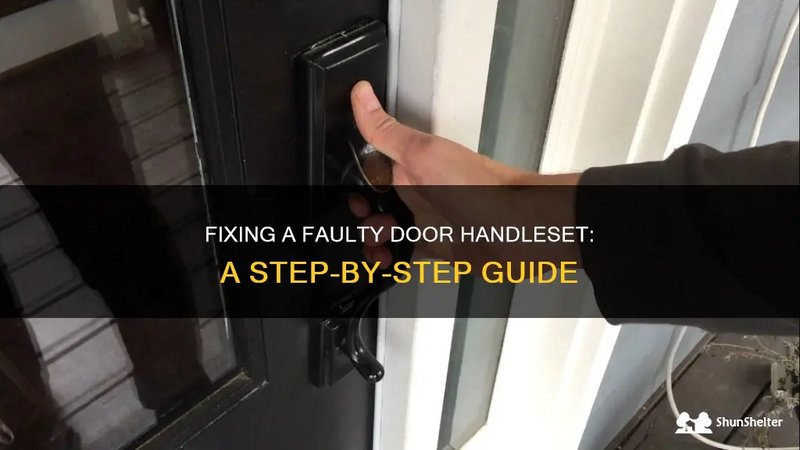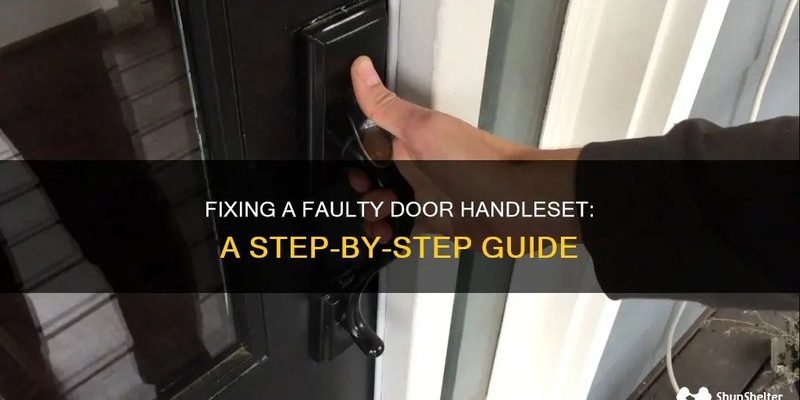
Handlesets from brands like Schlage, Kwikset, and Yale are built to be sturdy, but even the best can develop this annoying wiggle over time. Maybe it’s been years of heavy use or just a poorly installed set. Either way, if your handleset has excessive vertical play, it’s worth fixing—both for security and for your own peace of mind. Let’s untangle why it happens and how you can bring your door hardware back to snug, satisfying order.
What Is Vertical Play in a Handleset?
Vertical play is just the fancy way of saying your door handle moves up and down more than it should. Honestly, it’s one of those things you might not even notice until it starts to get really obvious—something feels loose, and suddenly you can jiggle the handle an inch in either direction. Manufacturers like Schlage or Kwikset design their handles to be firm and solid when new, so if you’re getting that extra movement, something’s changed.
Vertical play usually means some part of the mechanism has worn down, loosened, or maybe even broken. This sloppiness can start to mess with how the latch catches, how the lock syncs up, and even how well your door seals against the weather. If you keep ignoring it, the wiggling can get worse, leading to a full-on handleset failure (and nobody wants to deal with a door you can’t get into—or worse, one you can’t keep closed).
You might be wondering: does excessive vertical play mean my lock is less secure? The short answer is yes, sometimes. A loose handleset makes it easier to force the lock or pry things apart, so fixing it isn’t just about keeping your door looking nice—it’s about real security, too.
Why Do Handlesets Develop Excessive Vertical Play?
Here’s the thing: handlesets are under a lot of stress. Every time you open, close, or lock your door, the hardware takes a bit of a beating. Over years, that adds up, especially if the lock was never installed quite right to begin with. Even top-tier brands like Kwikset or Yale aren’t immune.
There are a few big culprits behind vertical play:
- Loose mounting screws: These are the screws that hold the handleset tight against the door. If they work loose, the whole thing can start to move.
- Worn or stripped spindle: The spindle is the bar that connects the two halves of the handle. If it’s worn out or stripped, things can shift up and down inside the mechanism.
- Damaged internal springs: Springs inside the latch or handle return it to position. If these break or lose tension, you’ll notice sagging and extra play.
- Poor installation: Sometimes it’s as simple as the lock not being paired up with the door thickness or material correctly. Gaps and misalignments lead to looseness.
It’s a bit like driving a car with loose lug nuts. Everything might seem okay, but eventually, you’ll feel the wobble—and that’s your warning to fix it before something fails completely.
Signs That Your Handleset Needs Attention
You might notice the problem in just a subtle way at first. Maybe your door doesn’t latch as firmly. Or maybe the lever doesn’t spring back like it used to. If you’re feeling a lot of vertical give, don’t wait—because it usually gets worse over time.
Common signs include:
- Handle moves up and down without resistance.
- The latch doesn’t catch smoothly or seems out of sync.
- The lock feels misaligned or sticks.
- You hear rattling or clicking when you use the handle.
These aren’t just small annoyances. Excessive vertical play can eventually stop your lock from working altogether, leaving your home vulnerable or simply locking you out. It’s like a smoke alarm chirping—ignore it long enough, and you’re asking for trouble.
If you have a smart lock or a handleset with extra tech features, troubleshooting is even more important. Some models can go into “reset” or “pairing” mode incorrectly if there’s too much movement, leading to code or sync issues.
Tools and Parts You’ll Need for the Repair
Don’t worry—you don’t need a full toolbox or any specialized gadgets to fix most handlesets with vertical play. Most fixes are straightforward and can be tackled with a few basic tools.
Here’s what you’ll usually need:
- Screwdrivers (Phillips and flathead): For removing the lock and tightening mounting screws.
- Allen wrenches or a small hex key: Some handlesets, especially from brands like Schlage, use set screws that require these.
- Replacement screws: If the originals are stripped or too short.
- Lubricant (like graphite powder): Optional, but good to have if things feel sticky.
- Replacement spindle or springs: If your inspection shows these are damaged.
Let me explain: If you’re dealing with a particularly old or unique handleset, finding the right replacement parts can be a pain. Having the brand and model number (often stamped on the latch or inside the plate) makes searching for parts or help much easier. Many manufacturers have troubleshooting guides on their sites, and you can even reset or sync some modern locks if you have the right instructions.
Step-by-Step Guide to Repairing Excessive Vertical Play
Ready to dig in? Here’s how to get that handleset feeling solid again. Take your time, and don’t force anything—patience is key.
- Remove the Handleset: Unscrew the visible mounting screws on the inside plate. Carefully pull the handles off both sides of the door.
- Inspect the Spindle and Springs: Look for obvious wear—flattened, stripped spots, or broken metal. Springs should be tight and bouncy, not saggy or bent.
- Tighten or Replace Screws: Using the right screwdriver or Allen wrench, snug up all the screws. If any spin freely or won’t catch, replace them with longer or slightly thicker ones for a firmer fit.
- Replace Damaged Parts: Swap out any worn spindles or broken springs. These can be ordered from the lock manufacturer or found at most hardware stores.
- Reinstall the Handleset: Line up everything carefully and reinstall, tightening each screw incrementally to keep it level.
- Test for Play: Before closing the door, try the handle several times. There should be little to no vertical movement left, and the latch should return smoothly.
If your repair doesn’t fix the vertical play, don’t get discouraged. Sometimes the issue is hidden deeper in the mechanism, or your door may be slightly warped, needing a new handleset that pairs better with the current setup.
What If My Handleset Still Has Vertical Play?
You might be wondering, “What if I do all of this and still have that annoying wobble?” Here’s where things get a bit more advanced. Sometimes the problem isn’t just in the handle or the obvious screws—it’s in the door itself or the way the lock body codes up with its housing.
If the wood around your lock is worn, the screws can’t grip properly, making everything feel loose no matter what. In that case, you may need to:
- Fill oversized holes with wood filler or toothpicks and wood glue, then re-drill for a tight fit.
- Upgrade to a universal handleset with stronger mounting options, designed to sync with a range of door thicknesses.
For smart or remote-activated locks, you could run into issues where the internal programming won’t reset or pair correctly due to excess movement. Make sure all electronic parts are secured, and if needed, consult your manufacturer’s troubleshooting steps or contact support for a reset code.
Comparing Universal Versus Brand-Specific Handlesets
Let’s have a quick side-by-side. Universal handlesets are designed to fit almost any standard door, and they often come with extra mounting hardware. These are great if your original lock’s mounting holes are stripped or if you want more flexibility in style and features—like a remote, code, or battery-powered lock.
On the flip side, brand-specific handlesets (like those from Yale, Schlage, or Kwikset) are tailored to work perfectly with their latches and deadbolts. They sync up better with the original hardware, making for a smoother repair if you want to keep everything matching.
- Universal: More flexible, often easier for tricky repairs, but sometimes less sturdy if not installed well.
- Brand-specific: Usually a perfect fit, higher security, and often better long-term reliability, but might cost more or require special order parts.
If you want a quick fix and don’t care about matching brands, universal sets can work. But if you’re after that just-right feel and long-term durability, sticking with the original brand is often your best bet.
How to Prevent Future Vertical Play
Now that your handleset is back to tight and sturdy, here’s how to keep it that way. Regular maintenance is key. Every few months, check your mounting screws for tightness. Handlesets, especially on busy entry doors, can work loose just from daily use.
A little bit of lubricant in the moving parts (skip anything greasy—dry graphite is safest) can keep things operating smoothly. Avoid slamming or hanging heavy items from the handle, which puts extra stress on the spindle and springs.
If you ever notice new play, don’t ignore it. Small adjustments now prevent big problems (and expensive replacements) later. For battery-powered or smart locks, a regular sync and reset can help catch issues before they mess with your setup.
Taking a few minutes every season to check your door hardware keeps your entryway secure and makes sure you never have to deal with that “loose handshake” feeling again.
Fixing a handleset with excessive vertical play isn’t rocket science—but it does take a little patience and attention. Whether you’re working with a classic Schlage or a high-tech Kwikset remote lock, getting rid of that unwanted wiggle helps your door lock, latch, and look their best. Even if the repair takes a couple of tries, you’ll appreciate the satisfying clunk of a well-fitted handle every time you come home.
Keep an eye on your hardware, tighten things up as needed, and don’t be afraid to try a universal set if your original hardware is past its prime. With just a bit of effort, your door will greet you (and your guests) with confidence and style—no more shaky handshakes or second guesses.
